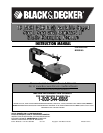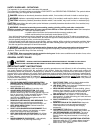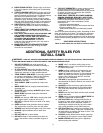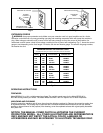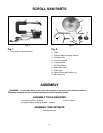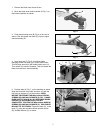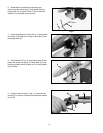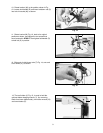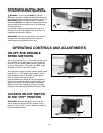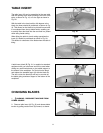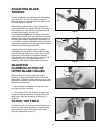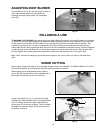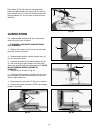
4
2. Grounded, cord-connected machines intended for
use on a supply circuit having a nominal rating less
than 150 volts:
If the machine is intended for use on a circuit that has an
outlet that looks like the one illustrated in Fig. A, the
machine will have a grounding plug that looks like the
plug illustrated in Fig. A. A temporary adapter, which looks
like the adapter illustrated in Fig. B, may be used to
connect this plug to a matching 2-conductor receptacle as
shown in Fig. B if a properly grounded outlet is not
available. The temporary adapter should be used only
until a properly grounded outlet can be installed by a
qualified electrician. The green-colored rigid ear, lug, and
the like, extending from the adapter must be connected to
a permanent ground such as a properly grounded outlet
box. Whenever the adapter is used, it must be held in
place with a metal screw.
NOTE: In Canada, the use of a temporary adapter is
not permitted by the Canadian Electric Code.
WARNING: SHOCK HAZARD. IN ALL CASES,
MAKE CERTAIN THE RECEPTACLE IN QUESTION IS
PROPERLY GROUNDED. IF YOU ARE NOT SURE
HAVE A QUALIFIED ELECTRICIAN CHECK THE
RECEPTACLE.
1. All grounded, cord-connected machines:
In the event of a malfunction or breakdown, grounding
provides a path of least resistance for electric current to
reduce the risk of electric shock. This machine is
equipped with an electric cord having an equipment-
grounding conductor and a grounding plug. The plug
must be plugged into a matching outlet that is properly
installed and grounded in accordance with all local codes
and ordinances.
Do not modify the plug provided - if it will not fit the outlet,
have the proper outlet installed by a qualified electrician.
Improper connection of the equipment-grounding
conductor can result in risk of electric shock. The
conductor with insulation having an outer surface that is
green with or without yellow stripes is the equipment-
grounding conductor. If repair or replacement of the
electric cord or plug is necessary, do not connect the
equipment-grounding conductor to a live terminal.
Check with a qualified electrician or service personnel if
the grounding instructions are not completely understood,
or if in doubt as to whether the machine is properly
grounded.
Use only 3-wire extension cords that have 3-prong
grounding type plugs and matching 3-conductor
receptacles that accept the machineʼs plug, as shown in
Fig. A.
Repair or replace damaged or worn cord immediately.
POWER CONNECTIONS
A separate electrical circuit should be used for your machines. This circuit should not be less than #12 wire and
should be protected with a 20 Amp time lag fuse. If an extension cord is used, use only 3-wire extension cords which
have 3-prong grounding type plugs and matching receptacle which will accept the machineʼs plug. Before connecting
the machine to the power line, make sure the switch (s) is in the “OFF” position and be sure that the electric current is
of the same characteristics as indicated on the machine. All line connections should make good contact. Running on
low voltage will damage the machine.
WARNING: SHOCK HAZARD. DO NOT EXPOSE THE MACHINE TO RAIN OR OPERATE THE
MACHINE IN DAMP LOCATIONS.
GROUNDING INSTRUCTIONS
WARNING: SHOCK HAZARD. THIS MACHINE MUST BE GROUNDED WHILE IN USE TO PROTECT
THE OPERATOR FROM ELECTRIC SHOCK. Your machine is wired for 120 Volt, 60 HZ alternating
current. Before connecting the machine to the power source, make sure the switch is in the “OFF” position.
27. NEVER reach under the table while the machine is
running.
28. NEVER perform layout, assembly or set-up work on
the table while the saw is operating.
29. ALWAYS STOP the saw before removing scrap
pieces from the table.
30. WHEN THE TOOL IS NOT IN USE, the switch
should be locked in the “OFF” position to prevent
unauthorized use.
31. SHOULD any part of your Scroll Saw be missing,
damaged or fail in any way, or any electrical
component fail to perform properly, shut off switch
and remove plug from power supply outlet. Replace
missing, damaged or failed parts before resuming
operation.
32. ADDITIONAL INFORMATION regarding the safe
and proper operation of this product is available
from the National Safety Council, 1121 Spring Lake
Drive, Itasca, IL 60143-3201, in the Accident
Prevention Manual for Industrial Operations and
also in the Safety Data Sheets provided by the
NSC. Please also refer to the American National
Standards Institute ANSI 01.1 Safety Requirements
for Woodworking Machinery and the U.S.
Department of Labor OSHA 1910.213 Regulations.
SAVE THESE INSTRUCTIONS.
Refer to them often
and use them to instruct others.



